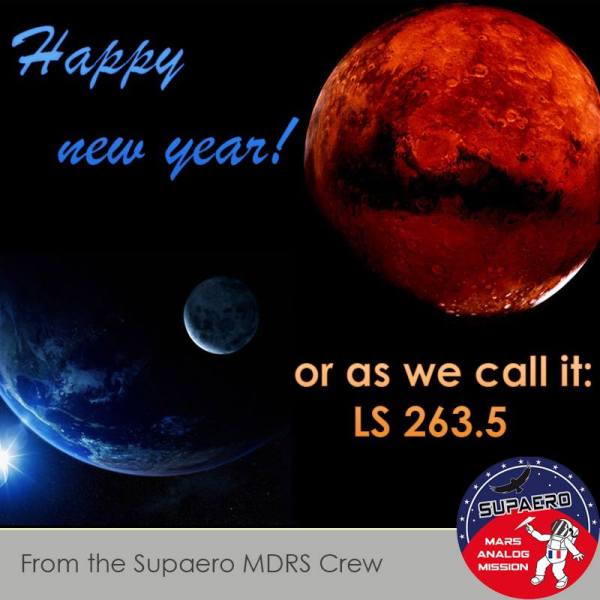31 Décembre 2014

Happy new year’s eve everyone ! Can you guys guess what does « LS 263.5 » stand for ?
28 Décembre 2014
Présentation du Cliff Reconnaissance Vehicle (CRV)

Présentation du Cliff Reconnaissance Vehicle (CRV), un robot conçu par les Français de Planète Mars afin de déplacer des instruments et des capteurs sur un terrain accidenté ou le long d’une falaise. Les membres de l’équipage MDRS Supaéro l’emmèneront lors de leur prochaine mission dans le désert de l’Utah afin de continuer à le tester en condition d’EVA (Sortie ExtraVéhiculaire) et d’améliorer les instruments (notamment la caméra embarquée).
The CRV is intended to send cameras and/or scientific instruments downhill on slopes which are not safely accessible by men mostly when they are operating in space suits. The CRV 3-4 used for the 2013 Morocco simulation and as provided by Planète Mars association is only equipped with a camera.
Till now, and it was also the case in the 2012 Dachstein, experimentation, main objective have been to demonstrate the vehicle mobility capabilities on slopes with more or less obstacles, different slope angles (even including more than 90° i.e. overhanging) which can be summarized as “terrain trafficability demonstration”. One understandable objective is to be able to retrieve and bring back uphill the vehicle. One particular objective for the Morocco simulation may be, accordingto available photos of the area, to test the vehicle on very high cliffs. Most tests till now have been conducted on less than 18 m high cliffs. Higher cliffs will increase the elastic behavior of the rope.
The second objective is to assess what are the operating difficulties when the vehicle is operated by an operator in spacesuit. A derived objective is to test the operations only with the gloves (either Aouda gloves or gloves provided by Association Planète Mars).
The third objective, either for operator in a spacesuit or without spacesuit is to assess and see how to improve the vehicle situation awareness. The situation awareness is obtained through the forces feeling by the operator on the suspension rope, through visual observation of the vehicle and through the information transmitted uphill by the on board video camera. The visual observation may come from the operator himself but the direct visual link is often quickly lost when the vehicle is in the slope. Then the operator may stop the operations, tie the suspension rope to the anchoring point and have a look from another point to see the vehicle. Or someone else may observe the vehicle from a different point and send information to the operator.

The third objective, linked to the present type of instrument on board (i.e. a camera) is to assess geological interpretation capabilities. This activity is conducted in house outside the experiment field. Other instruments may be fitted on the vehicle if wished by other participants. The main limitation is the weight. The payload plate is a multiperforated plate which allows for different types of fixations (bolts, T raps,…)
Objective one, two and three results are obtained through the report and comment from the operator on the difficulties encountered during the operations or the features which were judged useful to conduct the experiment. These objectives need also a photographic coverage of the slope to assess the level of difficulty and if possible a video coverage of the vehicle operations in the slope.
13 Décembre 2014
Partenariat avec Optinvent, fabricant français de lunettes à réalité augmentée

La start-up française Optinvent, fabricant de lunettes à réalité augmentée, a confirmé son partenariat avec le MDRS Supaéro Crew. La société, basée à Rennes, permettra à l’équipage d’utiliser ses lunettes lors de son séjour sur la MDRS, notamment afin d’étudier leur utilité en condition de sortie extra-véhiculaire. Les lunettes pourront permettre de rendre rapidement disponibles des informations sur la localisation des marsonautes : cartes, relevés météo, etc…
Clear-Vu is a patented game changing display technology for AR eyewear applications. It allows see-through vision while displaying a virtual image simultaneously. The Clear-Vu system has a high see-through ratio, wide viewing angle, is light weight, and shatter proof. Furthermore, it is the most cost effective and scalable approach available for near to eye display products as all key components are based on molded plastic. « Clear-Vu » is at the heart of the « ORA » line of products.
The ORA digital eyewear platform enables a multitude of hands free wireless mobile computing applications such as location based services, logistics, maintenance, sports, messaging, situation awareness, and much more. It can run applications as a standalone wearable computer and can connect via WiFi and Bluetooth to any smart device. The virtual screen of the ORA has two configurations allowing both « augmented reality » and « glance » modes. This « Flip-Vu » feature allows the image to be either directly in the wearer’s field of view or just below. The ORA is equipped with a dual core processor w/ GPU, camera, microphone, sound, inertial sensors, WiFi, Blootooth, GPS, ambient light sensor, photochromic lenses, and a high capacity rechargeable battery. The ORA is a new mobile computing paradigm allowing for a truly unique hands-free AR experience.
Source : http://optinvent.com/